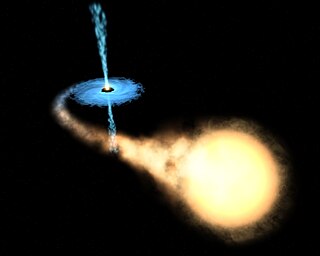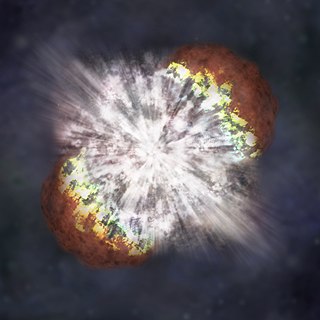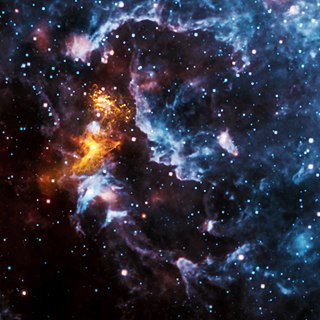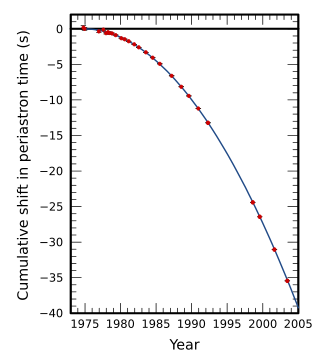
IGR J11014−6103, also called the Lighthouse Nebula, is a pulsar wind nebula trailing the neutron star which has the longest relativistic jet observed in the Milky Way galaxy.

IGR J11014−6103, also called the Lighthouse Nebula, is a pulsar wind nebula trailing the neutron star which has the longest relativistic jet observed in the Milky Way galaxy.
The object consists of a neutron star with a radius of about 12 km, which formed about 10,000–30,000 years ago in a supernova explosion. The supernova explosion "kicked" the neutron star, which is now moving through space with a velocity of between 0.3% and 0.8% of the speed of light, faster than almost all other known runaway neutron stars. The pulsar is now about 60 light-years from the original supernova location.
The neutron star is the source of a relativistic helical jet, which is observed in X-rays but has no detected radio signature. [1] In the composite processed image (right) the neutron star pulsar is the point-like object with a pulsar wind nebula tail trailing behind it for about 3 light-years. The jet, aligned with the pulsar rotation axis, is perpendicular to the pulsar's trajectory and extends out over 37 light-years (about nine times the distance from the Sun to the nearest visible star). The estimated velocity of the jet is about 80% of the speed of light.
The star was initially presumed to be rapidly spinning but later measurements indicate that its spin rate is only 15.9 Hz. [2] [3] This rather slow spin rate and the fact that there is no evidence of accretion suggests that the jet is neither rotation nor accretion powered. A counter-jet (not shown in the image) has been detected, but is much fainter, possibly due to relativistic beaming. [4] [5] The origin of the glitch at about a third of the jet length is not known, but it might be due to the jet switching off and on or the jet orientation changing.

A neutron star is the collapsed core of a massive supergiant star. It results from the supernova explosion of a massive star—combined with gravitational collapse—that compresses the core past white dwarf star density to that of atomic nuclei. Surpassed only by black holes, neutron stars are the second smallest and densest known class of stellar objects. Neutron stars have a radius on the order of 10 kilometers (6 mi) and a mass of about 1.4 M☉. Stars that collapse into neutron stars have a total mass of between 10 and 25 solar masses (M☉), or possibly more for those that are especially rich in elements heavier than hydrogen and helium.

The Crab Nebula is a supernova remnant and pulsar wind nebula in the constellation of Taurus. The common name comes from a drawing that somewhat resembled a crab with arms produced by William Parsons, 3rd Earl of Rosse, in 1842 or 1843 using a 36-inch (91 cm) telescope. The nebula was discovered by English astronomer John Bevis in 1731. It corresponds with a bright supernova recorded by Chinese astronomers in 1054 as a guest star. The nebula was the first astronomical object identified that corresponds with a historically-observed supernova explosion.

X-ray binaries are a class of binary stars that are luminous in X-rays. The X-rays are produced by matter falling from one component, called the donor, to the other component, called the accretor, which is either a neutron star or black hole. The infalling matter releases gravitational potential energy, up to 30 percent of its rest mass, as X-rays. The lifetime and the mass-transfer rate in an X-ray binary depends on the evolutionary status of the donor star, the mass ratio between the stellar components, and their orbital separation.

A super-luminous supernova is a type of stellar explosion with a luminosity 10 or more times higher than that of standard supernovae. Like supernovae, SLSNe seem to be produced by several mechanisms, which is readily revealed by their light-curves and spectra. There are multiple models for what conditions may produce an SLSN, including core collapse in particularly massive stars, millisecond magnetars, interaction with circumstellar material, or pair-instability supernovae.
X-ray pulsars or accretion-powered pulsars are a class of astronomical objects that are X-ray sources displaying strict periodic variations in X-ray intensity. The X-ray periods range from as little as a fraction of a second to as much as several minutes.

A pulsar wind nebula, sometimes called a plerion, is a type of nebula sometimes found inside the shell of a supernova remnant (SNR), powered by winds generated by a central pulsar. These nebulae were proposed as a class in 1976 as enhancements at radio wavelengths inside supernova remnants. They have since been found to be infrared, optical, millimetre, X-ray and gamma ray sources.

3C 58 or 3C58 is a pulsar and supernova remnant within the Milky Way. The object is listed as No. 58 in the Third Cambridge Catalogue of Radio Sources.

A pulsar is a highly magnetized rotating neutron star that emits beams of electromagnetic radiation out of its magnetic poles. This radiation can be observed only when a beam of emission is pointing toward Earth, and is responsible for the pulsed appearance of emission. Neutron stars are very dense and have short, regular rotational periods. This produces a very precise interval between pulses that ranges from milliseconds to seconds for an individual pulsar. Pulsars are one of the candidates for the source of ultra-high-energy cosmic rays.

The Crab Pulsar is a relatively young neutron star. The star is the central star in the Crab Nebula, a remnant of the supernova SN 1054, which was widely observed on Earth in the year 1054. Discovered in 1968, the pulsar was the first to be connected with a supernova remnant.

An astrophysical jet is an astronomical phenomenon where outflows of ionised matter are emitted as extended beams along the axis of rotation. When this greatly accelerated matter in the beam approaches the speed of light, astrophysical jets become relativistic jets as they show effects from special relativity.

A millisecond pulsar (MSP) is a pulsar with a rotational period less than about 10 milliseconds. Millisecond pulsars have been detected in radio, X-ray, and gamma ray portions of the electromagnetic spectrum. The leading hypothesis for the origin of millisecond pulsars is that they are old, rapidly rotating neutron stars that have been spun up or "recycled" through accretion of matter from a companion star in a close binary system. For this reason, millisecond pulsars are sometimes called recycled pulsars.

PSR J0737−3039 is the first known double pulsar. It consists of two neutron stars emitting electromagnetic waves in the radio wavelength in a relativistic binary system. The two pulsars are known as PSR J0737−3039A and PSR J0737−3039B. It was discovered in 2003 at Australia's Parkes Observatory by an international team led by the Italian radio astronomer Marta Burgay during a high-latitude pulsar survey.

The Hulse–Taylor pulsar is a binary star system composed of a neutron star and a pulsar which orbit around their common center of mass. It is the first binary pulsar ever discovered.
A pulsar kick is the name of the phenomenon that often causes a neutron star to move with a different, usually substantially greater, velocity than its progenitor star. The cause of pulsar kicks is unknown, but many astrophysicists believe that it must be due to an asymmetry in the way a supernova explodes. If true, this would give information about the supernova mechanism.

A binary pulsar is a pulsar with a binary companion, often a white dwarf or neutron star. Binary pulsars are one of the few objects which allow physicists to test general relativity because of the strong gravitational fields in their vicinities. Although the binary companion to the pulsar is usually difficult or impossible to observe directly, its presence can be deduced from the timing of the pulses from the pulsar itself, which can be measured with extraordinary accuracy by radio telescopes.

A radio-quiet neutron star is a neutron star that does not seem to emit radio emissions, but is still visible to Earth through electromagnetic radiation at other parts of the spectrum, particularly X-rays and gamma rays.

Gamma-ray burst progenitors are the types of celestial objects that can emit gamma-ray bursts (GRBs). GRBs show an extraordinary degree of diversity. They can last anywhere from a fraction of a second to many minutes. Bursts could have a single profile or oscillate wildly up and down in intensity, and their spectra are highly variable unlike other objects in space. The near complete lack of observational constraint led to a profusion of theories, including evaporating black holes, magnetic flares on white dwarfs, accretion of matter onto neutron stars, antimatter accretion, supernovae, hypernovae, and rapid extraction of rotational energy from supermassive black holes, among others.
The Magnificent Seven is the informal name of a group of isolated young cooling neutron stars at a distance of 120 to 500 parsecs from Earth. These objects are also known under the names XDINS or simply XINS.

A hypernova is a very energetic supernova which is believed to result from an extreme core collapse scenario. In this case, a massive star collapses to form a rotating black hole emitting twin astrophysical jets and surrounded by an accretion disk. It is a type of stellar explosion that ejects material with an unusually high kinetic energy, an order of magnitude higher than most supernovae, with a luminosity at least 10 times greater. Hypernovae release such intense gamma rays that they often appear similar to a type Ic supernova, but with unusually broad spectral lines indicating an extremely high expansion velocity. Hypernovae are one of the mechanisms for producing long gamma ray bursts (GRBs), which range from 2 seconds to over a minute in duration. They have also been referred to as superluminous supernovae, though that classification also includes other types of extremely luminous stellar explosions that have different origins.
PSR J1946+2052 is a short-period binary pulsar system located 11,000–14,000 light-years (3,500–4,200 pc) away from Earth in the constellation Vulpecula. The system consists of a pulsar and a neutron star orbiting around their common center of mass every 1.88 hours, which is the shortest orbital period among all known double neutron star systems as of 2022. The general theory of relativity predicts their orbits are gradually decaying due to emitting gravitational waves, which will eventually lead to a neutron star merger and a kilonova in 46 million years.